People spent less and saved more in December. The Personal Income and Outlays report covers individual income, consumption and savings. Consumer spending was basically flatlined, or -0.02% from last month, while disposable income increased by 0.4%. Personal income increased 0.5% That great holiday shopping record sales hype did not materialize in the aggregate spending statistics, as we pointed out in the retail sales overview. The personal income & outlays report is seasonally adjusted.
Personal consumption expenditures are often called consumer spending and in real dollars, or adjusted for price increases, declined -0.1% from November. Real Personal Consumption Expenditures, or PCE, are about 70% of GDP. We saw mediocre personal consumption for the quarter, which rose only 2%. Real means chained to 2005 dollars, or adjusted for inflation. Below is a graph of real PCE.
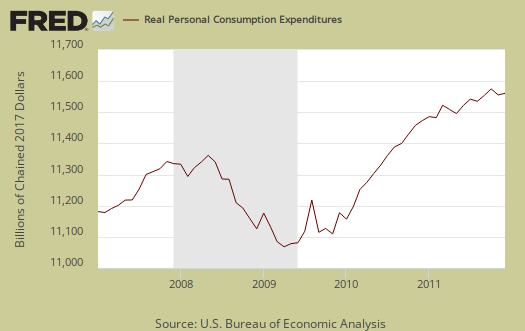
Consumer spending is not just smartphones, toys and Starbucks. Things like housing, healthcare, food and gas are part of consumer spending. Consumer spending for the majority is spending to pay basic living necessities. Graphed blow is the overall real PCE monthly percentage change.
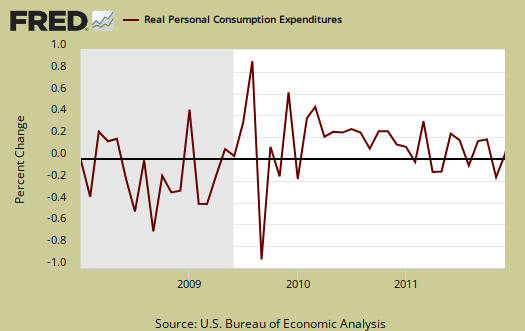
Here's what people spent money on in December, adjusted for prices, or in real dollars. Health care, for example, is a service. Gasoline is a nondurable good.
Purchases of durable goods decreased 0.1 percent, in contrast to an increase of 0.7 percent. Purchases of nondurable goods decreased 0.1 percent, the same decrease as in November. Purchases of services decreased 0.1 percent in December, in contrast to an increase of 0.1 percent in November.
Price indexes are used as divisors to adjust for inflation and price changes. The indexes are used to compute spending and income for an apples to apples, real dollar comparison to previous months and years. Economic statisticians use real dollars so one does not erroneously assume economic growth when it's really inflation.
The PCE price index increased 0.1% for December and is up +2.4% from December 2010. Minus energy and food, the price index increased + 0.2% and is also up +1.8% from this time last year. While the PCE price index represents inflation, it is different from CPI.
Personal income increased +0.5% in December and these numbers are the total for everybody in the United States who is reported and not part of the underground economy. Below is personal income, not adjusted for inflation, or price changes.
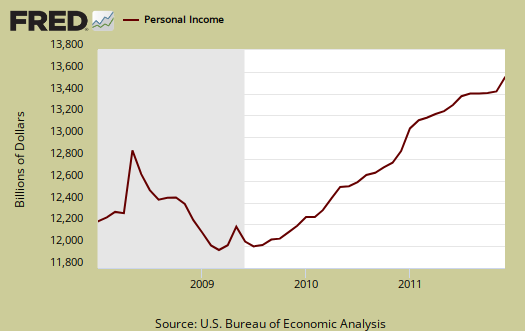
Real personal income, or personal income adjusted for inflation, via the PCE price index, was up +0.3% for December. Below is the graph of real personal income. While personal income is everybody, all income in the U.S., we can see it's below 2008 levels when adjusted for inflation.
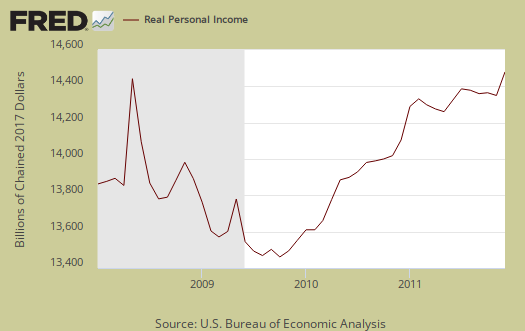
Disposable income is what is left over after taxes. DPI (disposable income), increased 0.4% from November. DPI adjusted for inflation (see the price indexes above), increased 0.3% from the previous month. These numbers are aggregates, which includes income of the uber-rich, or the 1% of the population, as they are now called.
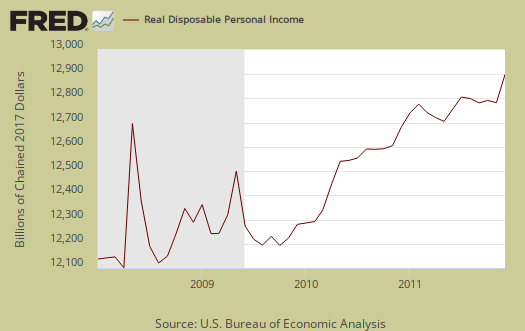
Below is real disposable income per capita. Per capita means evenly distributed per person and population increases every month. December mid-month the U.S. population was 313,1090,000 and increased 177,000 from November.
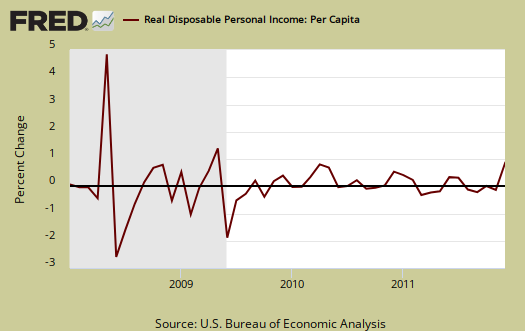
Interesting reality check huh? It seems politically, any mention of the effects of population on aggregate data is a no no and dismissed. Disposable income, when spread across increased population growth and adjusted for inflation shows it's often worse news, which makes declines even more miserable. The numbers reported in the press headlines are aggregates, or the total, regardless of how many more people are in the country.
The monthly percentage change for wages and salaries was 0.4%, with total employee compensation, which includes wages, salaries, benefits, also increasing 0.4%. Landlords made out like bandits, their income increased 1.9% in a month. Personal interest income declined -0.3% yet dividend income shot up by 1.5%. This is income from non-incorporated businesses, such as the self-employed.
Private wage and salary disbursements increased $29.1 billion in December, in contrast to a decrease of $1.4 billion in November . Goods-producing industries' payrolls increased $10.8 billion, in contrast to a decrease of $6.5 billion; manufacturing payrolls increased $7.4 billion, in contrast to a decrease of $6.2 billion. Services -producing industries' payrolls increased $18.3 billion, compared with an increase of $5.1 billion. Government wage and salary disbursements increased $0.4 billion in December; government wage s and salaries were unchanged in November.
Below are wages and salaries for the past decade. Notice the dip and the more flat line than earlier in the decade. Bear in mind these are aggregate, or all wages and salaries, and not adjusted for inflation.
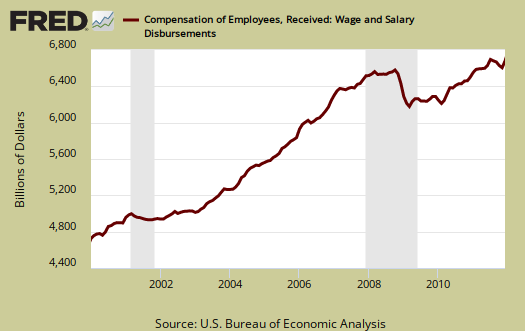
Below is personal income minus personal current transfer receipts. This graph shows how much personal income increased that wasn't funded by the government and is used as a recession indicator. Transfer receipts are payments from the government to individuals where no actual services (work) was performed. This includes social security, unemployment insurance, welfare, veterans benefits, Medicaid, Medicare and so on. This month, in chained 2005 dollars, real personal income minus transfer receipts increased +0.4% from last month. Notice real personal income minus transfer receipts is below pre-recession levels, so this sign of life is a welcome change. Make no mistake, we still have a long way to go. Real income, has not recovered from this recession (or maybe 2001 as well), and this should be no surprise from the jobs crisis alone.
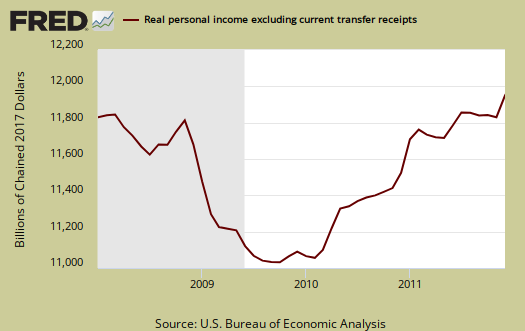
Personal savings is disposable income minus outlays, or consumption and not adjusted for inflation. The Personal Savings Rate was 4.7% in December.
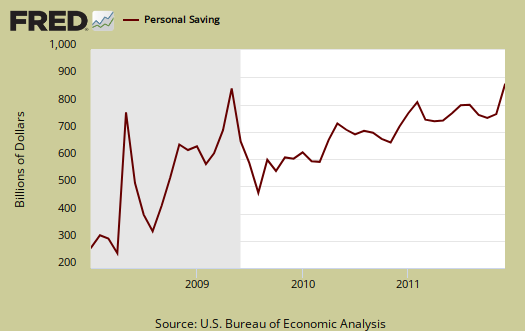
Below is disposable personal income minus personal consumption expenditures monthly raw total changes.

Personal Outlays are PCE, personal interest payments, and personal current transfer payments. PCE is defined above by percentages is almost all of personal outlays. Personal interest payments are things like the interest you pay on your credit card. Personal transfer payments are defined as:
Payments consisting of transfer payments by persons to government and to the rest of the world. Payments to government include donations, fees, and fines paid to Federal, state, and local governments, formerly classified as "personal nontax payments."
In other words, personal transfer payments are nothing more than that speeding ticket you just got or how you just donated to this site. People often confuse transfer payments with transfer receipts, not the same thing.
To visualize more data from this report, consider playing around with more of the St. Louis Federal Reserve Fred graphs.
Here is November's report overview, not revised.

Recent comments